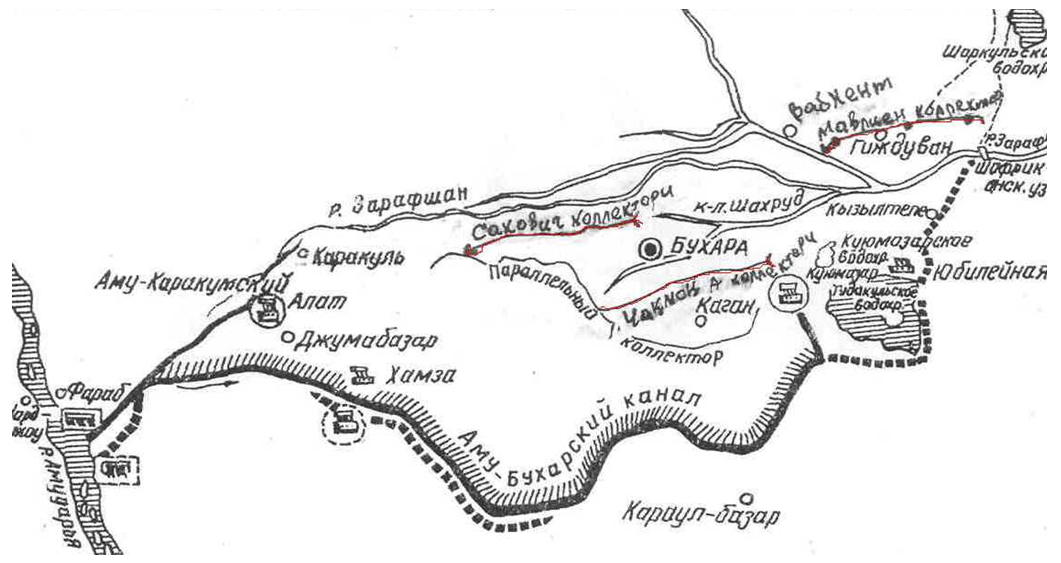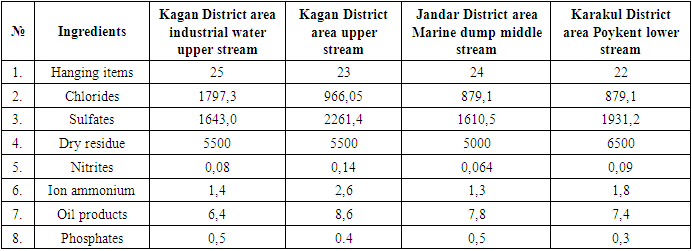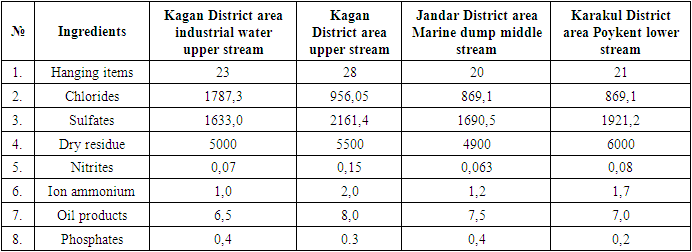-
Paper Information
- Paper Submission
-
Journal Information
- About This Journal
- Editorial Board
- Current Issue
- Archive
- Author Guidelines
- Contact Us
International Journal of Virology and Molecular Biology
p-ISSN: 2163-2219 e-ISSN: 2163-2227
2023; 12(2): 22-27
doi:10.5923/j.ijvmb.20231202.02
Received: Jun. 27, 2023; Accepted: Jul. 19, 2023; Published: Jul. 26, 2023

Algae of the Dengizkul Collector Waters
Z. F. Khodjaeva, N. E. Rashidov
Bukhara State University, Bukhara, Uzbekistan
Correspondence to: Z. F. Khodjaeva, Bukhara State University, Bukhara, Uzbekistan.
| Email: |  |
Copyright © 2023 The Author(s). Published by Scientific & Academic Publishing.
This work is licensed under the Creative Commons Attribution International License (CC BY).
http://creativecommons.org/licenses/by/4.0/

The article presents analysis of water samples obtained by research carried out in the lower, middle, upper reaches of the seaside collector of Bukhara region. In addition, as a result of research carried out in the Dengizkul collector between 2020 and 2022, several dominant types of algae were bred in laboratory conditions. The purification of the hydro chemical composition of the water of the Dengizkul collector with the help of algae was achieved.
Keywords: Microscopic algae, Plankton, Bentos, Hydrobiont, Salinity
Cite this paper: Z. F. Khodjaeva, N. E. Rashidov, Algae of the Dengizkul Collector Waters, International Journal of Virology and Molecular Biology, Vol. 12 No. 2, 2023, pp. 22-27. doi: 10.5923/j.ijvmb.20231202.02.
Article Outline
1. Introduction
- Due to the shortage of Water Resources, Water Basin mineralization and their pollution by various chemicals are increasing in subsequent years. In the composition of collector-drainage waters, the number of different disease-dispersing bacteria of organic matter in subsequent times increases. Because often collectors are supplied from cities, factories and factories, as well as from agricultural enterprises (cattle farms, poultry farms, pig-breeding complexes, canned food farms, etc.).) the effluents that come out are thrown away without cleaning or in a immature purified state. In particular, all sewage from the cities of the guard, Kagan, Bukhara, Jandar, Karakul and Alat will be thrown into the Dengizkul collector and, as a result, will be put on the Dengizkul. Before using Collector waters, it is advisable to clean and use mineral salts, organic substances in their composition, as well as bacteria that spread various diseases. To reduce the level of soil salinity, to meet the water demand of agricultural crops, Amudarya water is used. In 1978, the volume of collector waters in Bukhara region amounted to 1494 million m3 [1]. Dengizkul collector as a continuation of the Shurarik ditch in the Navai region, the upper flow of the pond begins from the Kagan District of the Bukhara region (Figure 1). The sailor collector is considered the main throwing ditch and acts as a result of the pouring of several small ditch waters – the expulsion of water leaking from under the ground, poison water (Grunt waters) from the territory of the district. Length 126.4 km, commissioned in 1967. In 2016, it was renovated by the Kagan water construction organization [2].
 | Figure 1. Location of collectors |
2. Literature Review
- The dynamics of growth of some green algae in the Collector-drainage waters of the Bukhara region has been studied. According to the result of the study carried out in the collectors of the Bukhara region, 24 species and species of their waters were identified as the most common. In addition, about 850 algae and a total of 389 species and species were identified from the largest collectors in the Bukhara region – Lightning a, Sakovich and Mavliyan, of which 72 blue-green algae, 3 dinophytes, 163 diatoms, 19 Euglena algae and 132 green algae were identified. To reproduce them, a nutrient medium consisting of collector water and manure juice and a lotoc-type device for gross reproduction were created and recommended for use in the national economy [1].A.E.Ergashev studied the flora of collectors and ditches in the Bukhara region. As a result of the research, 365 species and species have been identified, 2 of which are hara, 4 pyrophytes, 12 euglenas, 78 are blue-green, 42 are green and 157 are belonging to diatom algae, and data on their seasonal development are also provided [3].
3. Materials and Methods
- The research work began in the spring season of 2020-2022 and was carried out in field and laboratory conditions. Hydrobiological samples were collected from the Dengizkul collector of Bukhara region once a month. During the research, the main three streams of the Dengizkul collector were covered:Upper flow of Kagan District of Bukhara region;Middle stream of Jondor District of Bukhara region;Lower reaches of Karakul District of Bukhara region;The analysis of the physico – chemical state of water consists of two types.1. Hydrochemical analyzes in field conditions.2. Hydrochemical analysis in laboratory conditionsIn field conditions, indicators of water temperature, color, clarity, turbidity and rn were determined. With the air temperature "TSN -15" thermometer, the water temperature should be determined using the WT-1 digital thermometer, and the thermometer should be kept at a sampling depth of at least 7-10 minutes to determine the temperature. To determine the clarity of the water is a common Secchi disk (a white plate with a diameter of 20 cm is fixed on a measuring rope).Water medium pH that is, the amount of hydrogen ion of water (pH)- using indicator paper, and the LPU-01 brand pH was measured in meters. The light was measured on the Yu-16 brand lux meter instrument. During the experiment, the DRL-400 lamp was used to provide the algae with light in laboratory conditions. All the remaining indicators of water were determined in laboratory conditions. In the conditions of the laboratory, the scientific laboratory of biotechnology and ichthyology of Bukhara State University and the scientific laboratory of the State Committee for Ecology and Environmental Protection Yu.Yu.Lurye [4;446-p] and N.S.Stroganov [5–; 195-p] analyzed by Styles.Plankton collection consists of two types: quality and quantity samples. In this, the Plankton net was used. Kapron No. 76, water inlet diameter No. 20. Samples from Bentos and periphyton were assembled by hand, using a scalpel and a knife. When determining the amount of phytoplankton, plankton samples were collected, mainly with a specially prepared kefir bottle (to a depth of 0.5; 3M). It was carried out according to the generally accepted method of collecting Material and its re-analysis. Having collected samples, a few drops of 4% formalin were dripped into it, and formalin was not added to the sample to isolate an algologically clean cell, and the number of species in both cases was determined. In the process of work, the XDS-3, B-380 microscope was used. The amount of phytoplankton was determined in ECZ/l, and biomass in mg, g / m3. In laboratory conditions, an increase in cells was observed, and the number was determined through the Goryaev chamber. At the end of the experiment, the cells of the algae were isolated using centrifuge.The following authors ' methods [8; 50-54-p,] used plant species determinants [6; 350-p, 7; 405-p] to distinguish and biomass algological pure species from within identified algae when identifying and reproducing the types of algae in the waters of the Marine collector. When determining the number and biomass of phytoplankton’s G.K. Plotnikov (2017) [9; 282-p] and others were identified using his literature in his authorship.
4. Results
- As the air temperature rises, the process of activation of hydrobionts begins. The water of the Marine collector is freshwater. At some times of the year, the amount of minerals increased and approached slightly salty. The main reason for this is the result of the waters flowing into the Marine collector from several collectors due to the reduction in the amount of salinity in the soil, which is carried out in the winter season. The water is clear; the clarity is seasonal in nature. The highest pointer 2.8-3.0 meters is observed in January February. And in the summer season, this pointer is 0.5-1.5 meters. Water temperature is closely related to air temperature. During the year, the average air temperature indicator was 20°C, and the water temperature indicator was 15.4°C. During the spring season may of the Dengizkul collector, hydrobiological samples were harvested. The Dengizkul collector began to flow higher than Kagan district in Bukhara region, coordinates 39°45′37.34″N, 64°38′07.64″E. The upper flow of the ditch is at the beginning of May, the air temperature is 18 0 – 190 C, the water temperature is 21.40 – 21.70 C. (hours: 6: 30). The depth of the ditch in the upper reaches is 1.5 – 2.0 meters. The clarity of the water is 1.0 meters. the pH-amount is 6.0 saline.The pond of Dengizkul dump middle stream continues its mission to transport the main pond Waters to the Dengizkul in a side-by-side position with the Kuymazar canal as a result of the pouring of several large and small ditches in the Jandar district. Coordinates 39°37′55.22 ″N, 64°06′10.7″E. The length of the throw middle stream of the ditch is 25 km, the service area is 480 ha. Samples were taken from the part of the ditch with the addition of the railway ditch and the Yakkatut ditch and from the areas of the ditch 10 meters away. At the beginning of May, the air temperature is 38 0 C, the water temperature is 23.40 – 23.50 C. (hours: 10: 40). In the middle parts of the throw middle stream of the ditch, the depth is 3 – 3.5 meters, in the previous kisms-2-2.5 meters. The clarity of the water is 1 -1.5 meters. it was found that the pH is 7, close to the amount of neutral saline. As a result of the addition of other ditch waters in the middle reaches of the ditch, the amount of suspended matter, chlorides and sulfates was found to be higher than the amount of indicators compared to other streams of the Dengizkul collector.The lower reaches of the Dengizkul collector are the largest in comparison with other areas, and the Karakul district corresponds to the Paykent area (figure 2). The saltwater ditch is poured into the Dengizkul collector as a result of its confluence into a ditch named Sayot and the pond Association, which has an area of 16.85 km in length. [10] The downstream, which forms an area of 16 km, flows through the Alat district by going to the Dengizkul collector. Coordinates 39°37′55.22″N, 64°06′10.7″E
 | Figure 2. View of all streams of the Dengizkul collector |
|
 | Figure 3. Reproduction of algae in the waters of the Marine collector |
5. Discussion
- Insufficient data on the cultivation of algae in collector waters, whether the collection of their biomass was fully created, and whether the algae growing in collector-drainage waters purified water not only by mineral substances, but also from various toxic substances, caused a lot of controversy in the conduct of scientific research. This is because many parts of sewage from livestock and industrial complexes are being disposed of in collector (pond) waters without being cleaned or chipped, creating great difficulties for the breeding of algae species in the aqueducts that exist in the area of the 126.4 km long marine collector. For example, when biological pools are aerated, the process of water purification there is accelerated, creating good conditions for the reproduction of algae.As a result, the process of water purification is accelerated by rapidly growing green, blue-green, diatom, Euglena algae in the Collector waters of biological pools. But the insufficient number of aerating devices in the territory of the Marine collector is not enough for the reproduction process of algae in the water. During the research work, it is possible to grow Chlorella vulgaris, Chlorella pyrenoidosa and Scenedesmus obliquus in large-scale containers and ponds in which artificial pools was created. Through it, it is possible to increase algae in the three main streams of the Marine collector, as well as to achieve an improvement in the hydrochemical state.
6. Conclusions
- In the waters of the lower, middle upper reaches of the Marine collector in the Bukhara region, the number of cells planted as a result of cleaning the waters from organo-minerals increased with the help of growing Chlorella vulgaris, Chlorella pyrenoidosa and Scenedesmus obliquus. This resulted in an increase in the amount of oxygen in water to 12.5-13.5 mg/l due to the photosynthetic process.Nitrogen compounds, nitrites, nitrates, phosphates contained in waters were completely absorbed by algae. As a result of the experiments, there was a decrease in a certain amount of chlorides and sulfates in the waters.Enrichment of collector water with ammophos fertilizer and manure juice has been found that the growth of green algae can be increased up to 2-2.5 times compared to that of collectors water.
References
| [1] | N.E. Rashidov Buxoro viloyati kollektorlarining algoflorasi (Monografiya) Buxoro - “Durdona” 2020 S. 7-13. |
| [2] | Xodjayeva Z. (2022). Geograficheskoe polojenie i ekologicheskiy analiz kollektora Dengizkul. (buxdu.Uz), 8(8). http://journal.buxdu.uz/index.php/journals_buxdu/article/view/5782. |
| [3] | Muzafarov A.M., Ergashev A, E., Xalilov S. Opredelitel sinezelenыx vodorosley Sredney Azii. Kn.1. – Tashkent.: Fan. 1987. – S. 3- 405. |
| [4] | Lue Yu.Yu. Analiticheskaya ximiya promishlennыx stochnыx vod. Moskva.: Ximiya, 1984 . - 446 s. |
| [5] | Strogonov N.S. Prakticheskoe rukovodstvo po gidroximii. – Moskva. 1980. – 195. |
| [6] | Muzafarov A.M., Ergashev A,E., Xalilov S. Opredelitel sinezelenыx vodorosley Sredney Azii. Kn.2. – Tashkent.: Fan. 1988. – S. 406-892. |
| [7] | Gollerbax M.M., Polyanskiy V.I. Opredelitel presnovodnыx vodorosley SSSR. Vыp.1. Obщaya chast / Presnovodnыe vodorosli i ix izuchenie. – M.: Sovetskaya nauka, 1951. - 350s. |
| [8] | Kvitko K. V. Poluchenie kultur ot otdelnыx kletok xlorellы // Issledovaniya po genetike. –L.: LGU. 1961. - S. 50-54. |
| [9] | Plotnikov G.K., Peskova T.Yu., Shkute A., Pupinya A., Pupinsh M. Sbornik klassicheskix metodov gidrobiologicheskix issledovaniy dlya ispolzovaniya v akvakulture. – M.: Akademicheskoe izdatelstvo Daugavpilsskogo universiteta. Saule, 2017. - 282 s. |
| [10] | Xodjayeva, Z. (2022). Sezonnыy analiz rva Dengizkul. sentr nauchnыx publikatsiy (buxdu. Uz), 8(8). Izvlecheno ot http://journal.buxdu.uz/index.php/journals_buxdu/article/view/4984 ODG582. 232. 263. 7. |
 Abstract
Abstract Reference
Reference Full-Text PDF
Full-Text PDF Full-text HTML
Full-text HTML
